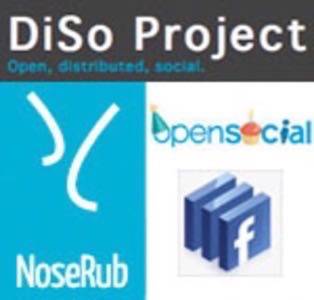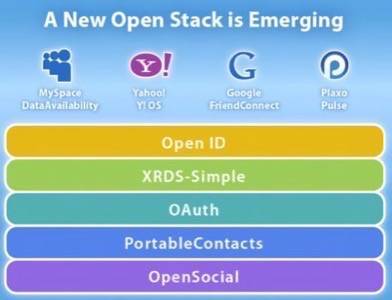Distributed social networking – where users can connect their profile, friends and other data across multiple sites – is still a relatively new concept and not fully developed. There are plenty of companies and projects vying to be a major piece of the distributed social networking puzzle. The big Internet companies have initiatives such as OpenSocial (Google), Facebook Connect, MySpace Data Availability, Yahoo! Open Strategy. There are also smaller company and open source projects such as DiSo and Noserub (we explain these below).

For users the following scenario explains the end goal, albeit too simplistically: in a distributed social networking world you would be able to access your Facebook friends in MySpace, and vice versa. Of course, it’s far from a perfect world and the Facebook-MySpace sharing scenario in particular is unlikely to happen any time soon. But slowly social networking is beginning to open up – and not just in the major social networks either.
We spotted an interesting screencast in the ReadWriteWeb Friendfeed room, The Future of Tech, that explains distributed social networking more.
Distributed Social Networking – An Introduction from pixelsebi on Vimeo.
The screencast was created by Sebastian Küpers, an Open Web and Virtual Worlds Evangelist from Germany. He starts by explaining that profiles are a building block of social networks – for example there’s a lot of useful profile data in his Facebook account that he’d like to use elsewhere. Friends/contacts, messaging, groups, and activity streams are other building blocks of social networks, explained Sebastian.
He mentioned two projects that are aiming to create distributed social networks by using open standards – DiSo Project (our coverage here and here) and Noserub (a German app). DiSo is basically an umbrella project for many of the leading open standards in the social Web currently – microformats, OpenID, OAuth and more. Noserub describes itself as a “protocol” and uses standards like OpenID, RSS and FOAF.
Sebastian outlined the following use case: if you are a MySpace user and want to add someone who isn’t a MySpace user to your friends list, right now you can’t. But if MySpace supported the open standards that Noserub, DiSo and others are advocating (microformats, OpenID, etc), then it would be possible for MySpace to support that scenario.
Key Differences Between DiSo/Noserub and OpenSocial/fbConnect
One question that people have about distributed social networks, which Sebastian might like to address in a future screencast, is what is the relation between open source projects like DiSo and Noserub, and ‘open data’ projects of the bigcos such as Google’s OpenSocial and Facebook Connect? Chris Messina, one of the founders of DiSo, pointed out one key difference in DiSo’s Google Group in June:
“Our model is rather different than OpenSocial as I understand it, as we’re trying to architect this in such a way that anyone can host their own friends list (for example) and not necessarily defer to Google, MySpace, etc… for starters.”
So for DiSo, they are using the WordPress blogging platform as their main vehicle for now. However in the same message, Chris mentioned that he’s “personally very interested in the overlap between DiSo and fbConnect and OpenSocial.” See also Marc Canter’s comments on DiSo, because Marc’s “open mesh” theories are very relevant here.
If Everything is So Open, Why Can’t We Connect Yet?
There is confusion right now because all the commercial vendors are positioning themselves as open – yet they don’t necessarily connect to each other! For example Google has been using the term “Open Stack” to explain what OpenSocial is doing. OpenSocial is still in development and it’s important to point out that Google doesn’t ‘own’ it, although it is obviously driving it. But OpenSocial isn’t being used by key players like Facebook and Microsoft; and when it is being used by bigcos it can be buggy – a RWW commenter recently remarked that MySpace’s OpenSocial implementation is “incredibly buggy”. So the fact that all of the main pieces of the distributed social networking puzzle are still in beta, goes some way to explaining why ordinary people can’t connect many of their profiles just yet.

We’d like to get some more feedback on distributed social networks in the comments – how would you explain the key differences between DiSo/Noserub and OpenSocial/fbConnect to people? How do you see all the different projects connecting together eventually?
Note: the idea for this post came from the ReadWriteWeb Friendfeed room, The Future of Tech. Thanks to Sebastian Küpers for posting it. If you’re want to inspire the RWW crew to write posts on certain topics, our Friendfeed room is a great place to let us know! Thanks also Zee for managing that room for us.





















